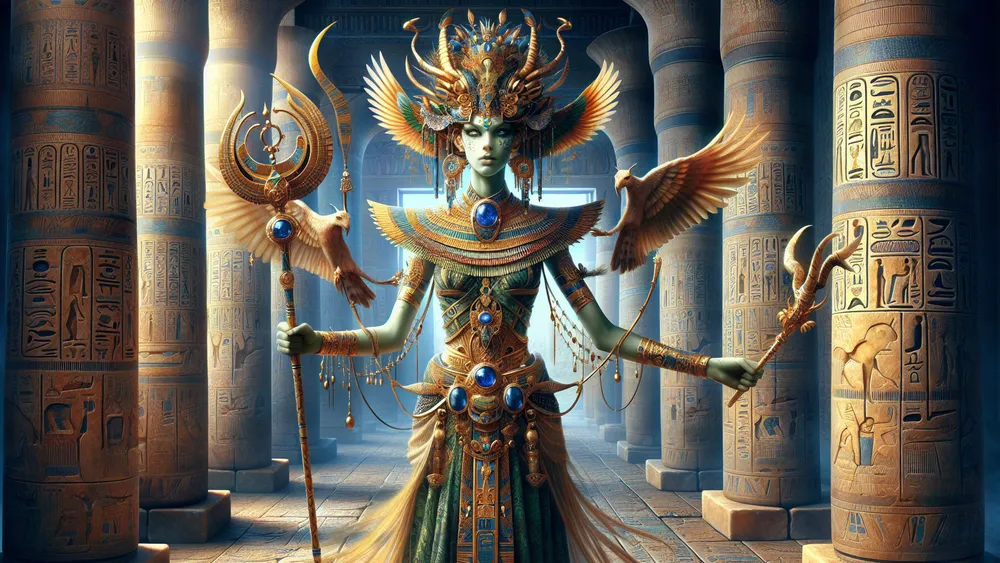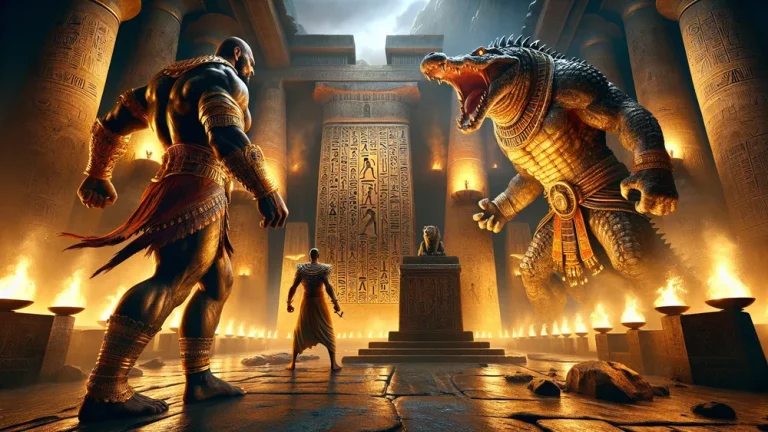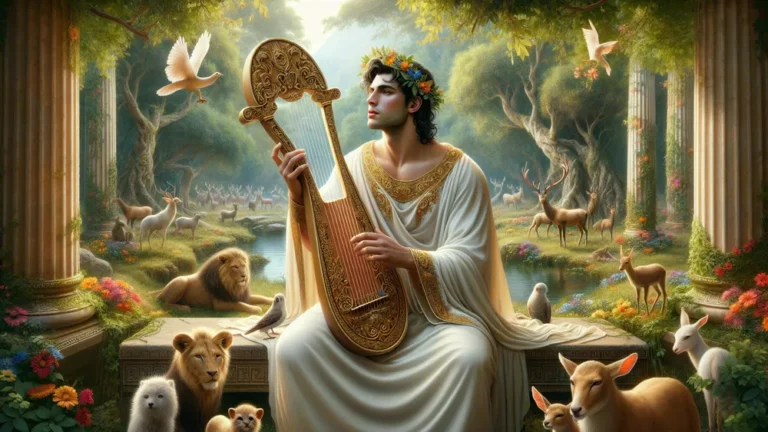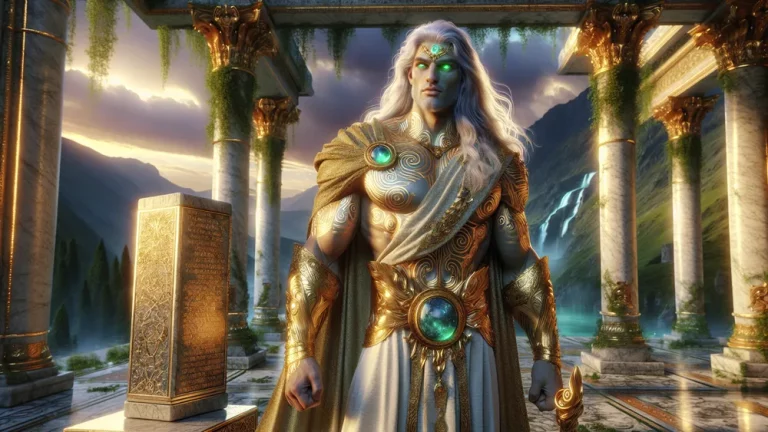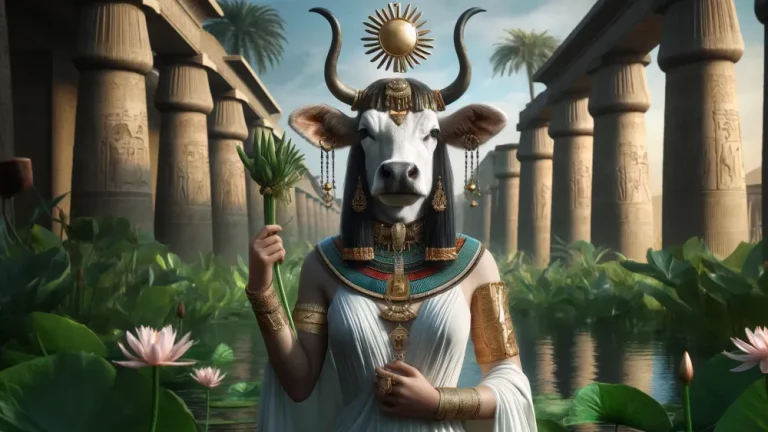The Story Of Osiris And Isis: An Ancient Egyptian Tale
Welcome to the interesting world of ancient Egyptian mythology, where gods played important roles that changed the beliefs and practices of one of history’s most intriguing civilizations. In this blog, you will learn the story of Osiris and Isis. It’s a story of love, betrayal, death, and coming back to life.
Key Points:
- Osiris and Isis are siblings born to Geb and Nut, with Set and Nephthys as their siblings.
- Osiris is the god of the afterlife, fertility, and resurrection; Isis is the goddess of magic and motherhood.
- Set kills Osiris out of jealousy and scatters his body parts.
- Isis, with the help of Nephthys and Anubis, finds and reassembles Osiris’s body, bringing him back to life.
- Horus, son of Osiris and Isis, avenges his father’s death by defeating Set.
- The story of Osiris and Isis influences Egyptian beliefs in resurrection, divine kingship, and the afterlife.
Think of a story like any drama you can find today, where a fight between siblings ends in a sad murder, and loyalty brings back life. We will explore this old tale and learn where Osiris and Isis began, their roles with the other Egyptian gods, and how their story affected Egyptian culture.
From the jealousy of Set to the hard work of Isis to bring Osiris back, this myth shows old Egyptian beliefs about life, death, and afterlife. So, let’s take this trip and find out the lasting impact of Osiris and Isis.
The Story Of Osiris And Isis: Overview and Key Facts
| Key Point | Description |
|---|---|
| Origins | Osiris and Isis are children of Geb (Earth) and Nut (Sky). |
| Brother and Sister | They have two others: Set, the god of disorder, and Nephthys, the goddess of sadness. |
| Osiris’s Role | Osiris, who is the god, deals with the afterlife, bringing back to life, and fertility. |
| Isis’s Role | Isis is the goddess handling magic, being a mother, and fertility. |
| Set’s Actions | Set was jealous, so he killed Osiris and spread his body parts. |
| Isis’s Duty | Isis looked for and put Osiris’s body parts back together to bring him back. |
| Bringing Back to Life | With her magic, Isis brought Osiris back. |
| Horus | The son of Osiris and Isis, who fought Set to get back at him for his father’s killing. |
| Big Influence | The story changed Egyptian ideas about rulers and life after death. |
| Worship Growing | People worshiped Isis even outside Egypt in places like Greece and Rome. |
How Osiris and Isis Came to Be
To see the big effect Osiris and Isis had on ancient Egyptian stories, it’s important to look at how they started and their family. By looking at their beginnings and their family tree, we can understand more. Let’s look into how they were born and their family ties.
Their Birth and Family Tree
Osiris and Isis, two important gods in ancient Egyptian stories, were born to Geb, the god of Earth, and Nut, the goddess of Sky. They also had Set and Nephthys, who were their brothers and sisters and played key roles in the story. While Geb and Nut were the parents, Osiris and Isis were good, and Set and Nephthys brought more complexity. For easier understanding, here’s an overview of their family:
- Geb (Earth): The father of Osiris, Isis, Set, and Nephthys.
- Nut (Sky): The mother of Osiris, Isis, Set, and Nephthys.
- Osiris: The god of the afterlife, bringing back to life, and fertility.
- Isis: The goddess of magic, being a mother, and fertility.
- Set: The god of disorder, jealousy, and storms, who became the enemy in the story.
- Nephthys: The goddess of mourning and protection, who helped Isis.
This family of gods sets up a story of love, betrayal, and redemption that people have found captivating for thousands of years.
Osiris, Isis, Set, and Nephthys, born to Geb and Nut, form a family of gods central to an ancient Egyptian tale of love, betrayal, and redemption.
What Osiris Did in Egyptian Myths
Osiris had an important place in old Egyptian stories as the god of the afterlife, bringing back to life, and growing crops. Think of Osiris as someone who protects and helps people move from living to being dead, making sure that dead people live forever. His jobs were big and important because he was believed to judge the dead people’s souls and allow them into the afterlife. Ancient Egyptians respected Osiris deeply, seeing him as a sign of starting again and new life, which shows in their farming and seasons. He was important in religious practices, with many rituals and ceremonies for him. To help you see his many roles, here’s a simple overview:
- God of the Afterlife: Osiris judged the souls of dead people and helped them live forever.
- God of Bringing Back to Life: He stood for starting again and new life, shaping ideas about life after death.
- God of Growing Crops: Osiris was linked to land fertility, helping to ensure good harvests.
Through these jobs, Osiris became a key part of old Egyptian religion, showing hope for life after death and the natural cycles of life.
The Sad Story of Osiris
Now that we know the important parts of Osiris and Isis, let’s look into the sad things that happened because of what Set did.
Set’s Betrayal
Osiris and his brother Set had strong envy and competition. Set envied Osiris’s popularity and power. Think of a family where one sibling always feels overshadowed by the other’s success. They had this dynamic. Set’s anger led to a clever plan to get rid of his brother. He made a beautiful chest that fit Osiris perfectly, and during a big feast, he said that whoever could fit well in the chest would win it. When Osiris lay down in the chest, Set and his helpers quickly closed it and threw it into the Nile River, which trapped and killed Osiris. Here’s a quick list of Set’s plan:

- Envy and Competition: Set wanted Osiris’s power and popularity.
- The Chest Trick: Set made a chest that fit Osiris exactly.
- The Feast: Set announced a contest at a feast, tempting Osiris to lie in the chest.
- The Execution: Set closed the chest and threw it into the Nile, killing Osiris.
This act of betrayal started a series of events that changed Egyptian stories forever.
The Death and Mutilation of Osiris
After catching Osiris in the chest and throwing it into the Nile, Set’s evil actions did not end there. He got Osiris’s body and, in an awful act, cut it up into fourteen pieces. Set then spread these pieces around Egypt, because he wanted to stop Osiris from coming back to life. Think of breaking a puzzle into pieces and spreading them far away.

Each piece of Osiris’s body was hidden in a different spot, making the search to find and put him back together a hard job.
The places where Osiris’s body parts were found held important meaning in Egyptian stories, since each spot became a place where people worshiped and showed respect. Here is a list of the places and the importance of each body part:
| Body Part | Place | Importance |
|---|---|---|
| Head | Abydos | Center of Osiris worship |
| Heart | Heliopolis | Sign of life and new beginnings |
| Right Arm | Letopolis | Strength and protection |
| Left Arm | Herakleopolis | Balance and justice |
| Right Leg | Memphis | Stability and foundation |
| Left Leg | Sais | Support and endurance |
| Torso | Busiris | Unity and central part |
| Other parts | Various places | Each spot became a local center for Osiris worship |
This spreading of Osiris’s body not only made his death sadder but also started the widespread respect for Osiris, as each place became a holy site.
Isis’s Devotion
Since Osiris’s body was spread around Egypt, this led to Isis showing her strong commitment and focused effort to bring her husband back.
Isis’s Journey to Reunite Osiris
Isis traveled to find and put together Osiris’s body parts, which showed her strong commitment and love. Think of looking for scattered pieces of something precious on a wide land; this was the big challenge Isis had. She went all over Egypt, because she was focused and had magic skills, to locate each piece of Osiris’s cut-up body.
Her effort was not just a physical journey but also a spiritual one, since she wanted to bring her husband back to life and restore balance.

While she traveled, Isis met many challenges but she was not alone. Her sister Nephthys, who also felt sad and focused, joined her in the search. Moreover, Anubis, the god of mummification and the afterlife, helped a lot. Together, they overcame problems like difficult places, magic barriers, and the ongoing risk of Set’s actions. Here’s a short list of the challenges and help Isis got:
Challenges:
- Difficult places and magic barriers
- The risk of Set’s actions
Help:
- Nephthys’s support and being there
- Anubis’s skills in mummification and advising
This team effort and the hard times they went through showed how strong their commitment was and how deep their love for Osiris went.
Bringing Osiris Back to Life
Because of her great magic skills, Isis was able to bring Osiris back to life, which showed her power and commitment. Think of a healer using skills to fix a body. Isis, with help from Nephthys and Anubis, pieced together Osiris’s body and did holy rituals to make him alive again. This was not just a surprising event but a key part of Egyptian stories.
Osiris’s return to life showed the endless cycle of death and rebirth, which greatly influenced Egyptian ideas about life after death. He became the god of the afterlife, showing the hope of coming back to life and living forever for all who followed the right path. This impacted core Egyptian religious practices and how they saw life after death.
Isis’s resurrection of Osiris symbolized the eternal cycle of life and death, profoundly influencing Egyptian beliefs in the afterlife.
The Birth and Challenges of Horus
After Osiris was brought back to life, Isis’s work was not done because she started focusing on the amazing birth and the challenges of their son, Horus.
The Arrival of Horus
After Osiris was brought back to life, the beginning and birth of Horus were amazing, a holy event. Think of hope coming during hard times. This was Horus, made by the magical joining of Isis and the resurrected Osiris. His birth was a sign of new beginnings and continuity, making sure that the story of Osiris would last. Since he was the son of two very strong gods, Horus was very important in Egyptian stories. He was seen as the example of holy kingship and the guardian of the pharaohs. Here’s why Horus was so important:
- Sign of New Beginnings: His birth showed life moving on and overcoming death.
- Holy Kingship: Horus was seen as the true heir to Egypt’s throne, having the best qualities of a ruler.
- Guardian of Pharaohs: He was thought to watch over and lead the pharaohs, connecting the gods and humans.
Horus’s arrival started a new part in the mythological story, leading to his future fights and victories.
Horus vs. Set
Horus and Set had a long and intense fight for the throne of Egypt which showed the ongoing fight between order and chaos. Think of a long court case where both sides argue strongly. This was the kind of holy contest between Horus, who was the rightful heir, and Set, who took the throne by force.
Their fight wasn’t just a physical fight but a series of tests of their strength, smarts, and staying power. The gods were often asked to mediate and judge these trials because of the cosmic importance of their struggle. Because he wanted to avenge his father’s death and claim his rightful place as the ruler of Egypt, Horus went through many problems and hard times.
These included direct fights with Set, traveling through dangerous places, and dealing with tricky plans. One well-known test was the “Contendings of Horus and Set,” which included things like boat races and turning into different animals. Even though he had many setbacks and got hurt, Horus’s strength and determination never faded.
His win over Set not just avenged Osiris but also brought balance and order back to the world, confirming the divine right of kingship and showing the victory of good over bad.
The Impact of Osiris and Isis
After Horus’s big fight against Set ended, the lasting impact of Osiris and Isis started to change the structure of ancient Egyptian culture and religion.
Shaping Egyptian Royalty
The story of Osiris and Isis greatly changed the idea of kingship in ancient Egypt, which made the pharaoh a god-like ruler who showed the ideas of Ma’at, or cosmic order. Just as Osiris was seen as the god of the afterlife and a sign of new life, the pharaoh was viewed as a living god who ensured the well-being and stability of the land.
Because of this, the Eye of Horus, a powerful sign showing protection, royal power, and good health, became very important. It was like a sign of authority, much like a modern-day national seal or crest, which made clear the pharaoh’s divine right to rule.

The Eye of Horus, often seen in royal clothes and charms, was a sign of the pharaoh’s sacred duty to keep justice and harmony, which showed the lasting impact of Osiris and Isis in shaping the very essence of Egyptian royalty.
The Spread of Isis Worship
Isis worship went beyond Egypt’s lines and reached the Greek and Roman world, turning into one of the most common and lasting groups of old times. Think about the influence of a modern cultural icon whose appeal crosses places and ideas; this was Isis’s reach. Her traits as a caring mother, a strong healer, and a protector connected with people far beyond Egypt.
Symbols linked with Isis, such as the throne headdress which showed her role as the queen of the gods and the ankh that stood for life, were everywhere in temples and personal charms across the Mediterranean.
The lasting impact of Isis can be seen in how her worship changed and fit with local customs, which made sure her veneration continued well into the Roman Empire and beyond, leaving a permanent mark on the religious scene of the old world.

FAQs
1. Who were the parents of Osiris and Isis?
The parents of Osiris and Isis were Geb, the god of the earth, and Nut, the goddess of the sky.
2. How did Set kill Osiris?
Set killed Osiris by tricking him into a chest, sealing it, and throwing it into the Nile River.
3. What role did Anubis play in the resurrection of Osiris?
Anubis played a crucial role in the resurrection of Osiris by assisting Isis in the mummification and reassembly of Osiris’s body.
4. How did the story of Osiris and Isis influence ancient Egyptian religion?
The story of Osiris and Isis influenced ancient Egyptian religion by establishing the concepts of resurrection, the afterlife, and divine kingship.

